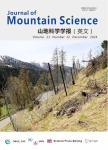Spatial Distribution of Large-scale Landslides Induced by the 5.12 Wenchuan Earthquake
Spatial Distribution of Large-scale Landslides Induced by the 5.12 Wenchuan Earthquake作者机构:State Key Laboratory of Geohazard Prevention and Geoenvironment Protection Chengdu University of Technology Chengdu 610059 China
出 版 物:《Journal of Mountain Science》 (山地科学学报(英文))
年 卷 期:2011年第8卷第2期
页 面:246-260页
核心收录:
学科分类:081803[工学-地质工程] 070801[理学-固体地球物理学] 07[理学] 08[工学] 0818[工学-地质资源与地质工程] 0708[理学-地球物理学]
基 金:sponsored by the project of the Chinese National Key Basic Research Program on "The failure mechanism and distribution rule of slopes under strong earthquakes" (Grant No. 2008CB425801) the Education Department Innovation Research Team Program (Grant No. IRT0812)
主 题:5.12 Wenchuan Earthquake Landslides Distribution pattern Direction effect Locked segment effect
摘 要:The 5.12 Wenchuan Earthquake in 2008 induced hundreds of large-scale landslides. This paper systematically analyzes 112 large-scale landslides (surface area 50000 m2), which were identified by interpretation of remote sensing imagery and field investigations. The analysis suggests that the distribution of large-scale landslides is affected by the following four factors: (a) distance effect: 80% of studied large-scale landslides are located within a distance of 5 km from the seismic faults. The farther the distance to the faults, the lower the number of large-scale landslides; (b) locked segment effect: the large-scale landslides are mainly located in five concentration zones closely related with the crossing, staggering and transfer sections between one seismic fault section and the next one, as well as the end of the NE fault section. The zone with the highest concentration was the Hongbai-Chaping segment, where a great number of large-scale landslides including the two largest landslides were located. The second highest concentration of large-scale landslides was observed in the Nanba-Donghekou segment at the end of NE fault, where the Donghekou landslide and the Woqian landslide occurred; (c) Hanging wall effect: about 70% of the large-scale landslides occurred on the hanging wall of the seismic faults; and (d) direction effect: in valleys perpendicular to the seismic faults, the density of large-scale landslides on the slopes facing the seismic wave is obviously higher than that on the slopes dipping in the same direction as the direction of propagation of the seismic wave. Meanwhile, it is found that the sliding and moving directions of large-scale landslides are related to the staggering direction of the faults in each section. In Qingchuan County where the main fault activity was horizontal twisting and staggering, a considerable number of landslides showed the feature of sliding and moving in NE direction which coincides with the staggering direction of th



